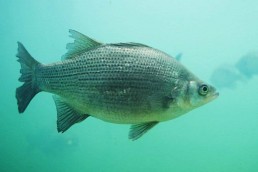White Bass: Underappreciated St. Clair Target
I felt like the odd man out.
John Cleveland, marketing director for Eppinger—makers of the iconic Dardevle spoon – was on the back deck of the bass boat, casting one of his company’s products. On the front deck, our host Jon Bondy was fishing a drop-shot rig with a Bondy perch, the latest in his line of soft-plastic baits.
Having no bait company of my own, I chose a Rapala X-Rap, which is always a good choice for early season, shallow-water bass fishing on Lake St. Clair.
We were fishing for smallmouths just down the lake from the yacht club and I was pretty much matching my host fish for fish, as was Cleveland, though he was producing totally different results. Bondy and I were catching smallmouths; Cleveland was catching white bass.
As we passed the break wall at the yacht club, I started hitting the whites, too. There was a current break there and the whites were stacked up in it. We caught a few whites as we moved farther up the lake, and a few smallmouths. The smallies were unremarkable for Lake St. Clair—14-, 15-, 16-inch fish—not the eye-popping hawgs you often encounter here, but nice enough. Bondy suggested we make a move.
It’s not my habit to second guess my hosts—especially anglers of Bondy’s stature—but I asked him to indulge me and let me have another whack at the whites. As he allowed we could, I tied on a jig head with a curly tail grub and as soon as we got within casting distance of the break wall, a white bass nailed my offering.
I unhooked it, dropped it back into the lake, and looked at my watch. My next cast connected with a white, as did my next and my next. So did Cleveland’s.
I told Bondy I wanted to see how long it would take me to catch 50. (Answer? It took 55 minutes, which included down time spent re-tying twice, as well as a half dozen impromptu photo sessions.)
I caught a fish nearly every cast and noticed once, when I went two casts in a row without boating one, that I had six strikes on those casts. Cleveland was catching whites at about a third the rate as I, which was a function of his lure choice; whenever I caught one, I could grab the head of the jig, give it a good shake, and let the fish fall back into the water. Cleveland—because of the treble hook on his spoon—had to go for the pliers.
You can catch white bass—when they’re active and willing—on just about anything, but I prefer the jig because of the ease of handling. White bass have sharp dorsal fin spines, sharp gill plates—sharp everything, it seems—and the less you have to handle them, the easier it is on you. Even still, I had cuts and poke marks on my fingers, as I wasn’t handling them quite gingerly enough.
Cleveland, who I think had enough of fighting the fins, set down his spinning rod and grabbed a fly rod and continued to catch the whites until I pronounced I had 50. Bondy said we had to move.
We went out to some rock piles in deeper water. It was pretty much the same drill—whites everywhere. Bondy switched from his drop-shot rig to a large, deep-diving crankbait and started catching whites, too.
“It’ll be like this through the end of June, at least,” Bondy said. “And I’ve seen years when it’s been steady through August—I mean seagulls diving on schooling fish and everything.”
I’ve been fishing with Bondy for nearly 20 years and have had many days when we ran into the white bass and caught 100 (or more) apiece. Bondy told me that on his best day ever, with two clients in the boat, they caught more than 1,300.
We probably could have done that this day, too, were we so inclined. But we kept moving, looking for smallmouths—and finding a few here and there—but catching mostly whites. Bondy said we would probably find more smallmouths if we headed farther up the lake, up toward Metro Beach.
“Every year is different,” he said. “This year the bass have been strong up the lake, around 14 Mile, 15 Mile Road.”
I really didn’t feel like a long boat ride as I was enjoying the white bite—and we were catching just enough smallmouths to keep it interesting.
White bass are perhaps the most under-appreciated fish in our waters. Relatives of striped bass (same genus: Morone), white bass hit like freight trains and fight like Joe Louis. Although they do not come out of the water, as black bass do, they come to the surface and pull, pull, pull. They do not enjoy the reputation as table fare of many other species, but I suspect that’s simply because most anglers in this part of the world haven’t given them a fair shake. Fillet them (they fillet easily, but watch those sharp spots), give them a little olive oil bath, coat ‘em with Cajun spices, and drop them in a white hot skillet for about a minute or so a side. They are excellent.
Because we were going bass fishing—we wound catching more than 20 smallies, by the by—I hadn’t brought a cooler along to take fish home. That was the only disappointment of my day well-spent on Lake St. Clair.
For more information…
For information on Bondy’s guide service and/or bait company, visit lakestclairfishing.com.
MWO
SHARE THIS POST
Did you enjoy this post?
You can be among the first to get the latest info on where to go, what to use and how to use it!




